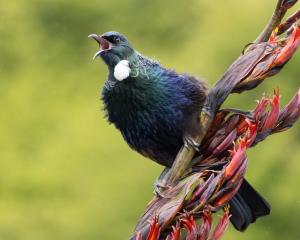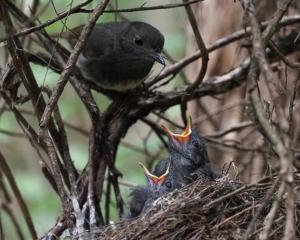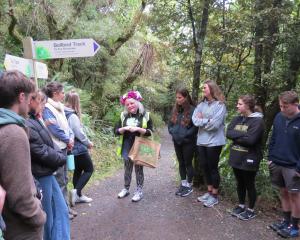Ancient New Zealand was a land of birds, which is what Orokonui Ecosanctuary will look and feel like in the future.
But like New Zealand was before people and mammalian predators and browsers arrived, Orokonui will have a rich invertebrate world as well, bristling with the diverse and hidden little creatures that lend vitality to the forest.
If you look a little closer, there are some amazing critters that benefit from the absence of hungry mammals.
Moths and butterflies are a striking group. New Zealand has relatively few butterflies but it was a great summer for coppers (genus Lycaena), and the admirals (Vanessa) and magpie moths (Nyctemera) stood out among the forest greens with their warning colours.
When it comes to moths, we don't do so badly, and fantails and other insectivorous birds pick them out of the air right in front of walkers - if you are lucky.
In late summer, the forest is alive at night with the Otago ghost moth Aoraia rufivena. Blotchy chocolate brown males with an impressive wingspan of 7cm fly swiftly in search of mouse-sized flightless females on the ground.
Another evening species is the lichen moth Declana egregia, an attractive black-and-white moth that appears on the $100 banknote. Confined to the South Island's lowland forests, this species is especially common at Orokonui Ecosanctuary. The larvae, which resemble bird droppings when at rest, feed on the three-finger shrub, Pseudopanax colensoi.
Many insects are disappearing with the last glimpse of summer warmth, bedding down as eggs or caterpillars deep in the leaf litter, or enveloped in pond slime to survive the chill.
As the bugs bed down, birds are hunting furiously for every last mouthful. Feathers keep them warm, but when it comes to a southern winter, fat is what counts.
Even the kaka, spoilt for choice with supplementary feeding at Orokonui, know that nature's super-foods will always be best.
With tough, hooked beaks, they tear at dead trees for the fat grubs inside, especially the wriggly white larvae of the huhu beetle, Prionoplus reticularis. The beetles fly in summer - you may hear clattering elytra around barbecue lights - and they can deliver a nasty nip if cornered.
Good nippers are to be expected from wood-eaters. Eggs are laid in dead wood and the larvae bore thumb-sized holes through the remnants of trees, gaining enough energy stores to become a beetle and begin the cycle again.
A wriggly parcel of concentrated energy is exactly what a kaka needs to build up reserves. Not every grub makes it through.
Perhaps we could take a leaf out of the kaka's book and eat grubs instead of cows - good nutrient balance and better for the planet.
As the nights get longer, not everyone laments the loss of the sun. Night is the spider's domain. Eye-shine in torchlight points out the many forest spiders.
Cambridgea is a genus found in New Zealand and prevalent in Orokonui's nightlife. These spiders don't build webs; instead, they lie in wait for anything that might stumble past.
Another spider you might be more familiar with is Dolomedes minor. It builds tight bundles of web in scrub - the nurseryweb spider's lair. On a sunny day, the female might even bask on the web, showing off her velvety browns.
Less well known is its sister, the fishing spider, Dolomedes aquaticus, poised at the water's edge awaiting vibrations that indicate water bugs or minute fish below. Using the water tension and purposefully hairy legs to dash across the surface, she will collect prey and dinner is done.
And last but not least of the strange creatures prowling this sanctuary is the peripatus, spraying its prey with high-speed glue and sucking them up when appropriately tender. Though rare, it's probably found in a forest near you. Luckily, it is small and actually very cool to watch. See it in action on Youtube.
There are five described species of peripatus in New Zealand (and as many as 30 more undescribed) and several inhabit Dunedin forests.
• Sofie Welvaert, who is doing a course in science communication at the University of Otago, is a keen educator at Orokonui Ecosanctuary.












